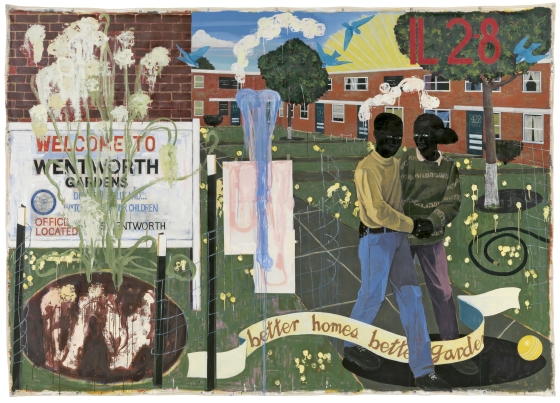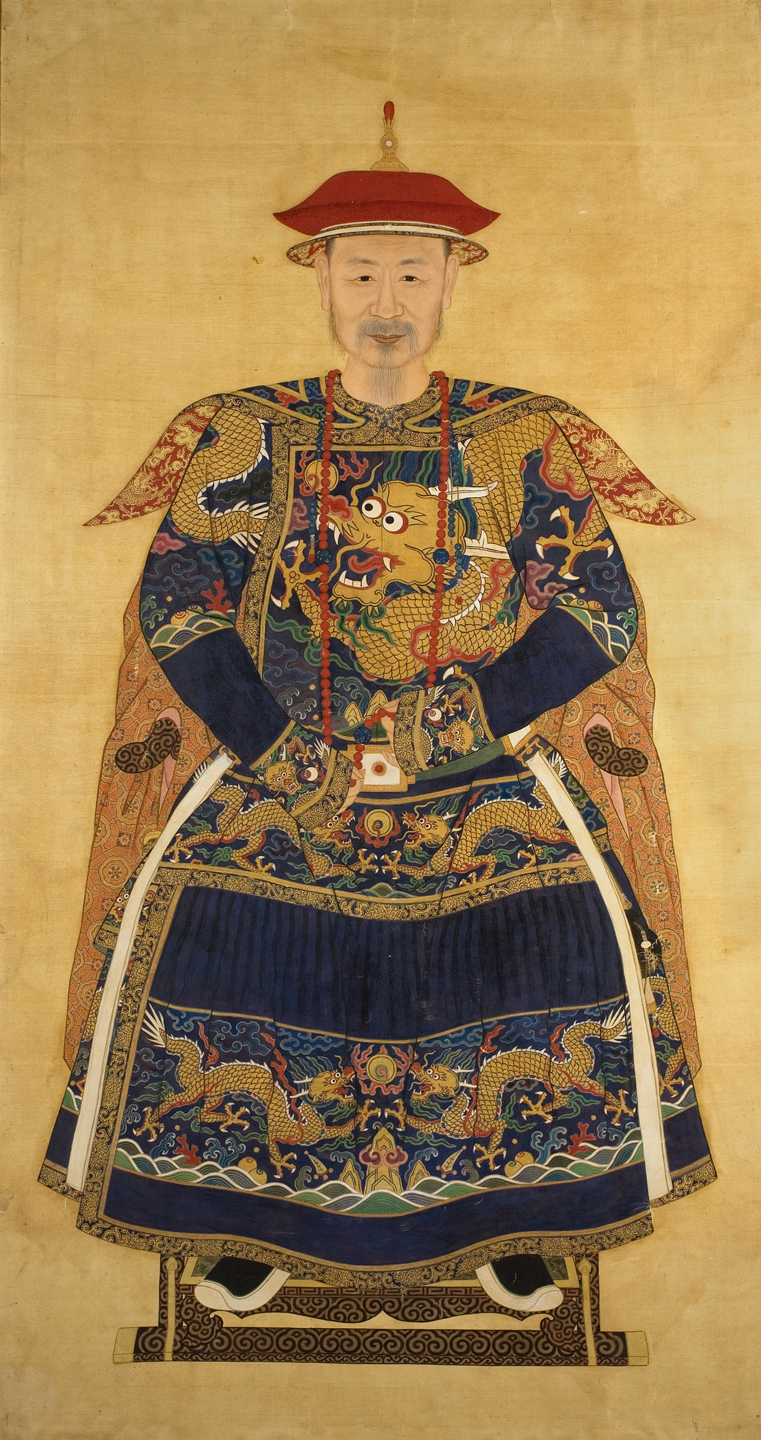Students will learn about Marshall’s creative process when painting Better Homes, Better Gardens and discuss how it influences their perception of his work. They will also discuss the thematic content of the artwork and write a creative piece inspired by the painting.
- discuss Marshall’s choice of images and painting techniques and their thoughts related thereto;
- examine visual images in the painting and draw details from them to inspire their writing; and
- feel comfortable editing their writing based on feedback from their peers.
Lesson
- Warm-up: Have students tell a partner about a one-block section of their neighborhood. The description should include more than just visual details (e.g. what sounds and smells do they notice?). It should also give the listener a sense of how living in the neighborhood makes their partner feel.
- Read the About the Art section as a class. Identify the parts of the picture discussed in the "Details" section. In small groups, analyze and critique Marshall’s choices in regards to subject matter, setting, and painting technique. How does letting the process show feel to them as they look at the painting? What if all paintings used this technique? Talk about the “invisible man” concept (explanation found in the "Details" section) and talk about what it would be like for the viewer if the concept were not used.
- Have students think 10 words to describe as much as they can about what they see in Marshall’s painting. Have students write a story about what happened a little before or after the moment frozen in the picture using the list of descriptive words and themes discussed earlier.
- Have students work in small groups to critique and edit their writing.
- Allow students to volunteer to read their stories to the entire class.
Materials
- Lined paper and pencil/pen for each student
- About the Art section on Better Homes, Better Gardens
- One color copy of the painting for every four students, or the ability to project the image onto a wall or screen
Standards
- Visual Arts
- Invent and Discover to Create
- Observe and Learn to Comprehend
- Relate and Connect to Transfer
- Envision and Critique to Reflect
- Language Arts
- Oral Expression and Listening
- Writing and Composition
- Reading for All Purposes
- Collaboration
- Critical Thinking & Reasoning
- Information Literacy
- Invention
- Self-Direction
Better Homes, Better Gardens
- Kerry James Marshall, American, 1955-
- Born: Birmingham, AL
- Work Locations: Chicago, IL
Kerry James Marshall was born in Birmingham, Alabama in 1955. Eight years later, his family moved to Los Angeles, California, where they lived in a housing project called Nickerson Gardens. He currently lives and works in Chicago, Illinois. Marshall received his BFA from Otis Art Institute in Los Angeles, California and was presented with an honorary doctorate in 1999.
Marshall’s work is often rooted in African-American popular culture, and draws upon his own childhood memories and experiences: “‘You can’t be born in Birmingham, Alabama, in 1955 and grow up in South Central [Los Angeles] near the Black Panthers headquarters, and not feel like you’ve got some kind of social responsibility. You can’t move to Watts in 1963 and not speak about it. That determined a lot of where my work was going to go,’ says Marshall.” He also brings together the traditions of artists from previous generations, combining everything that they’ve discovered about art to create something new: “It’s all up for grabs, it’s all material that can be combined to make something that nobody’s seen before.”
Better Homes, Better Gardens is part of a series of paintings that Marshall calls the “Garden Project.” The paintings in this series portray scenes that suggest the complexity of life in low-income housing projects. They are rich in references to art history, social history, and Marshall’s own personal history. According to Marshall, these paintings are “loaded with contradictions. That’s what makes work exciting.”
Better Homes, Better Gardens is set against the backdrop of an Illinois housing project. The homes all look the same and are part of a larger institutional building. The housing project code “IL 2-8” sits in the top right corner of the canvas. Marshall challenges the stereotypes of a housing project, however, by creating a more hopeful scene set against the institutional backdrop—two young people embrace one another as they stroll down a path; bluebirds flutter near the top of the painting; cheerful sunbeams pop up from behind the building. “What I wanted to show in those paintings is that whatever you think about the projects, they’re that and more. If you think they’re full of hopelessness and despair, you’re wrong. There are actually a lot of opportunities to experience pleasure in the projects.”
Details

Banner with Title
The title suggests an ideal place, an urban Garden of Eden. But the notion of improvement, of striving to better a less-than-ideal lot in life, seems to be part of the mix as well. The title, Better Homes, Better Gardens, calls to mind the well-known magazine, Better Homes & Gardens, which focuses on home improvement, gardening, and decorating. The title also refers to public housing projects whose names sometimes include the word “garden,” like Wentworth Gardens, depicted here.

Blackness of Skin Tone
The figures in Marshall’s work often have an intensely black skin color. He says, “A part of what I was thinking to do with my image was to reclaim the image of blackness as an emblem of power, instead of an image of derision.” However, here we find another contradiction. Although Marshall gives the figures a position of power, the “ultra-black” skin color makes their facial features difficult to see, making the figures nearly invisible. Marshall cites Ralph Ellison’s 1952 classic American novel The Invisible Man as the origin of his black figure. In this novel, the protagonist and narrator, a young, unnamed black man, views himself as socially invisible in a world dominated by intolerance, racism, and bigotry.Marshall says, “[W]hat I set out to do was to develop a figure or form that would represent that condition of invisibility, where you had an incredible presence, but there was a way in which you could sometimes be seen and not seen at the same time.”

The Code IL 2-8
This is the official designation of the public housing site in the state of Illinois. The idyllic setting that Marshall has created is challenged by the presence of this bureaucratic code.

Bluebirds and Sunbeams
The birds and the sunshine are symbols that Marshall describes as a “fantasy of happiness.”

Splotches of Paint
Marshall uses the paint splotches to disrupt the narrative flow of the scene. He creates a scene does not tell just one linear story, but a story that has many different parts. Marshall also believes that evidence of the process of painting is very important to the overall appearance of a finished work. He says, “Some of what’s evident in an unfinished painting is that it reminds me just how difficult making a painting is. It confirms the suspicion that I always had, that these things don’t come into existence by magic.” Here, Marshall deliberately leaves traces of his process by including these random splotches of paint.
Funding for object education resources provided by a grant from the Morgridge Family Foundation. Additional funding provided by the William Randolph Hearst Endowment for Education Programs, and Xcel Energy Foundation. We thank our colleagues at the University of Denver Morgridge College of Education.
The images on this page are intended for classroom use only and may not be reproduced for other reasons without the permission of the Denver Art Museum. This object may not currently be on display at the museum.







